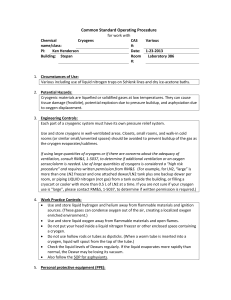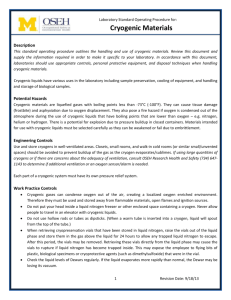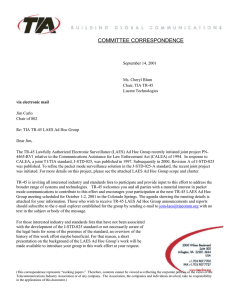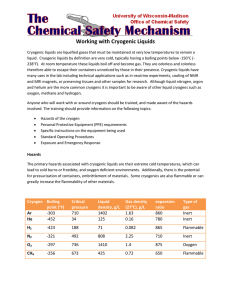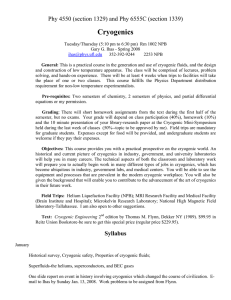Cryogenic Energy Storage
advertisement
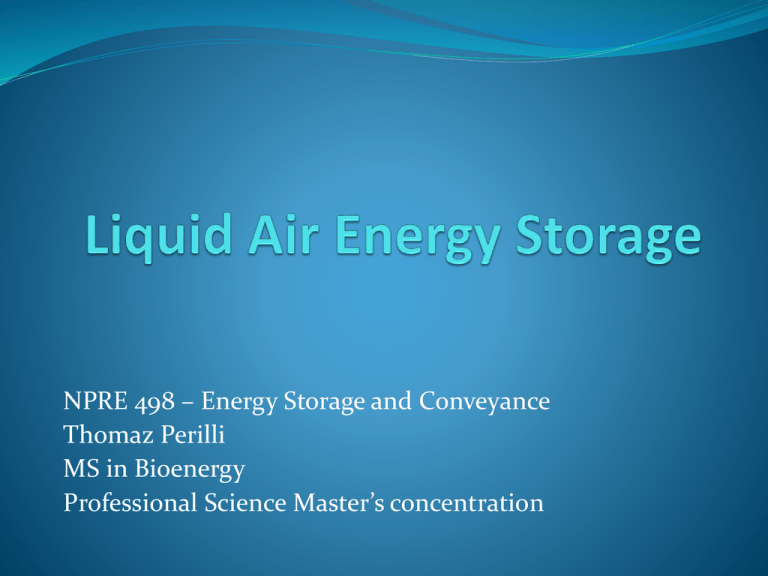
NPRE 498 – Energy Storage and Conveyance Thomaz Perilli MS in Bioenergy Professional Science Master’s concentration Outline Cryogenic Energy Storage Liquid Air Energy Storage Advantages Disadvantages Options Current Plant Future Projects Conclusions References Cryogenic Energy Storage (CES) Large energy storage method that uses a cryogen as an energy vector Excess energy from off peak hours or energy from intermittent renewable sources, such as wind and solar, is used to liquefy a gaseous substance Cryogen is stored Power is recovered through a thermodynamic cycle Liquid Air Energy Storage (LAES) Feedstock: air – free and abundant Air liquefies at -196°C Air to liquid air: 700 fold decrease in volume Specific energy: around 100-200 Wh/kg Three-stage process: Charge Storage Round-trip efficiency: up to 60% Discharge Advantages Existing global, industrial gases infrastructure and mature components with proven lifetime (25 years+) and performance Storage at low pressure LAES does not require scarce materials Low capital cost No geological constraints Synergy with other processes: Integration/recycling of waste heat Integration/recycling of waste cold LAES: cold recycle and waste heat LAES facility model Disadvantages Lower efficiency Safety issues: nitrogen leakage (boiling point lower than oxygen) Oxygen deficiency: outside tank Oxygen enrichment: inside tank Shorter storage time: hours to days Options Oxy-combustion Oxygen and nitrogen are separated Nitrogen is used as the storage media Oxygen is used in combustion processes: increases efficiency, reduces NOx pollution, eases CO2 recovery Nuclear Power Plant Excess electricity used to liquefy air Heat from NPP is used in the recover stage Round-trip efficiency: 71% Liquid nitrogen industry Current Plant Highview pilot plant Location: Slough, Greater London, England Operational since 2011 Power: 350 kW Efficiency: 8% Only half of the cold recycled Small size facility Next to a power station: waste heat synergy Future Projects Highview pre-demonstration unit Location: Pilsworth, Greater Manchester, England Expected to be operational by early 2015 Power: 5 MW Funding: $13.5 M – Department of Energy and Climate Change, UK Next to a landfill: waste heat synergy Partnership with GE Conclusion LAES has some interesting advantages and can play a minor role in energy storage if actual efficiency is brought closer to the theoretical efficiency “While in no way claiming to be a panacea to all our energy challenges, liquid air as an energy store has different attributes for which there is a real demand in a robust low carbon power and transport infrastructure.” References http://www.highview-power.com/wp-content/uploads/Highview Brochure.pdf http://www.liquidair.org.uk/about-liquid-air#ql-intro Chai L, Liu J, Wang L, Yue L, Yang L, Sheng Y, Chen H, Tan C. Cryogenic energy storage characteristics of a packed bed at different pressures. Applied thermal engineering 2014;63(1):439-446. Stöver, B., Rehfeldt, S., Alekseev, A., Stiller, Ch. (2013): Process engineering and thermodynamic evaluation of concepts for liquid air energy storage. Vienna: Power Gen. Li Y, Cao H, Wang S, Jin Yi, Li D, Wang X, Ding Y. Load shifting of nuclear power plants using cryogenic energy storage technology. Applied Energy 2014;113:1710-1716. http://www.highview-power.com/tour/


